Synthesis of (1,10-Phenanthroline-κ2N,N′)(β2-Methyl- and β2-PhenylAlaninate-κ2N,O)Copper(II) Nitrate Complexes and Their Antiproliferative Activity on MCF-7 and A549 Cancer Cell Lines
Abstract
1. Introduction
2. Results and Discussion
2.1. Synthesis and FT-IR Characterization
2.2. Single-Crystal X-Ray Diffraction Analysis
2.3. Crystalline Structure and Hirshfeld Surface Analysis
2.4. UV–Visible Spectroscopy
2.5. Electron Paramagnetic Resonance Spectroscopy
2.6. Cyclic Voltammetry and Conductometric Measurements
2.7. Effect on Growth Inhibition (IC50)
2.7.1. Staining with Fluorescent Dyes Acridine Orange (AO) and Propidium Iodide (PI)
2.7.2. Nuclei Staining with Hoechst 33258
2.7.3. DNA Fragmentation Assay
2.7.4. Apoptosis Detection with Annexin V FITC and Propidium Iodide
3. Materials and Methods
3.1. Reagents, Solvents, and Cell Lines
3.2. Instrumental
3.2.1. FT-IR
3.2.2. Mass Spectrometry
3.2.3. UV-Vis
3.2.4. EPR
3.2.5. Conductivity
3.3. Synthesis of the Copper (II) Complexes 3 and 4
3.4. Hirshfeld Surface
3.5. Cyclic Voltametric Measurements
3.6. Single-Crystal X-Ray Diffraction Analysis
3.7. Effective Magnetic Moment Measurements
3.8. Growth Inhibition (IC50 and Selectivity Index)
3.8.1. Staining with Fluorescent Dyes Acridine Orange (AO) and Propidium Iodide (PI)
3.8.2. Nuclei Staining with Hoechst 33258
3.8.3. DNA Fragmentation Assay
3.8.4. Apoptosis Detection with Annexin V FITC and Propidium Iodide
4. Conclusions
Supplementary Materials
Author Contributions
Funding
Institutional Review Board Statement
Informed Consent Statement
Data Availability Statement
Acknowledgments
Conflicts of Interest
References
- Siegel, R.L.; Giaquinto, A.N.; Jemal, A. Cancer statistics, 2024. CA Cancer J. Clin. 2024, 74, 12–49. [Google Scholar] [CrossRef] [PubMed]
- Huaizhi, Z.; Yuantao, N. China’s Ancient Gold Drugs. Gold Bull. 2001, 34, 24–29. [Google Scholar] [CrossRef]
- Dollwet, H.H.; Sorenson, J.R.J. Historic uses of copper compounds in medicine. Trace Elem. Med. 1985, 2, 80–87. [Google Scholar]
- Hodgkinson, V.; Petris, M.J. Copper Homeostasis at the Host-Pathogen Interface. J. Biol. Chem. 2012, 287, 13549–13555. [Google Scholar] [CrossRef]
- Williams, K.J. The introduction of ‘chemotherapy’ using arsphenamine—The first magic bullet. J. R. Soc. Med. 2009, 102, 343–348. [Google Scholar] [CrossRef]
- Rosenberg, B.; Camp, L.V.; Krigas, T. Inhibition of Cell Division in Escherichia coli by Electrolysis Products from a Platinum Electrode. Nature 1965, 205, 698–699. [Google Scholar] [CrossRef]
- Rosenberg, B. Platinum Complexes for the Treatment of Cancer. Interdisc. Sci. Rev. 1978, 3, 134–147. [Google Scholar] [CrossRef]
- Kelland, L. The resurgence of platinum-based cancer chemotherapy. Nat. Rev. Cancer 2007, 7, 273–584. [Google Scholar] [CrossRef]
- Hambley, T.W. Metal-based Therapeutics. Science 2007, 318, 1392–1393. [Google Scholar] [CrossRef]
- van Rijt, S.H.; Peacock, A.F.A.; Johnstone, R.D.L.; Parsons, S.; Sadler, P.J. Organometallic Osmium(II) Arene Anticancer Complexes Containing Picolinate Derivatives. Inorg. Chem. 2009, 48, 1753–1762. [Google Scholar] [CrossRef]
- Vitorino, A.H.; Mantovanelli, L.; Zanotto, F.P.; Espósito, B.P. Iron Metallodrugs: Stability, Redox Activity and Toxicity against Artemia salina. PLoS ONE 2015, 10, e0121997. [Google Scholar] [CrossRef] [PubMed]
- Dasgupta, S.; Karim, S.; Banerjee, S.; Saha, M.; Saha, K.D.; Das, D. Designing of Novel Zinc(II) Schiff Base Complexes Having Acyl Hydrazone Linkage: Study of Phosphatase and Anti-Cancer Activity. Dalton Trans. 2020, 49, 1232–1240. [Google Scholar] [CrossRef] [PubMed]
- Iacopetta, D.; Rosano, C.; Sirignano, M.; Mariconda, A.; Ceramella, J.; Ponassi, M.; Saturnino, C.; Sinicropi, M.S.; Longo, P. Is the way to fight cancer paved with gold? Metal-Based Carbene Complexes with Multiple and Fascinating Biological Features. Pharmaceuticals 2020, 13, 91. [Google Scholar] [CrossRef] [PubMed]
- Bharathi, S.; Mahendiran, D.; Kumar, R.S.; Choi, H.J.; Gajendiran, M.; Kim, K.; Rahiman, A.K. Silver(I) metallodrugs of thiosemicarbazoles and naproxen: Biocompatibility, in vitro anti-proliferative activity and in silico interaction studies with EGFR, VEGFR2 and LOX receptors. Toxicol. Res. 2020, 9, 28–44. [Google Scholar] [CrossRef] [PubMed]
- Thota, S.; Rodrigues, D.A.; Crans, D.C.; Barreiro, E.J. Ru(II) Compounds: Next-Generation Anticancer Metallotherapeutics? J. Med. Chem. 2018, 61, 5805–5821. [Google Scholar] [CrossRef]
- Valdez-Camacho, J.R.; Pérez-Salgado, Y.; Espinoza-Guillén, A.; Gómez-Vidales, V.; Tavira-Montalvan, C.A.; Meneses-Acosta, A.; Leyva, M.A.; Vázquez-Ríos, M.G.; Juaristi, E.; Höpfl, H.; et al. Synthesis, structural characterization and antiproliferative activity on MCF-7 and A549 tumor cell lines of [Cu(N-N)(β3-aminoacidate)]NO3 complexes (Casiopeínas®). Inorganica Chim. Acta 2020, 506, 119542. [Google Scholar] [CrossRef]
- Lummen, G.; Sperling, H.; Luboldt, H.; Otto, T.; Rubben, H. Phase II trial of titanocene dichloride in advanced renal-cell carcinoma. Cancer Chemother. Pharmacol. 1998, 42, 415–417. [Google Scholar] [CrossRef]
- Lessa, J.A.; Parrilha, G.L.; Beraldo, H. Gallium complexes as new promising metallodrug candidates. Inorganica Chim. Acta 2012, 393, 53–63. [Google Scholar] [CrossRef]
- Fernández-Gallardo, J.; Elie, B.T.; Sadhuka, T.; Prabha, S.; Sanaú, M.; Rotenberg, S.A. Heterometallic titanium-gold complexes inhibit renal cancer cells in vitro and in vivo. Chem. Sci. 2015, 6, 5269–5283. [Google Scholar] [CrossRef]
- González-Ballesteros, M.M.; Mejía, C.; Ruiz-Azuara, L. Metallodrugs: An approach against invasion and metastasis in cancer treatment. FEBS Open Bio 2022, 12, 880–899. [Google Scholar] [CrossRef]
- Matsui, K.; Masuda, N.; Uchida, Y.; Fukuoka, M.; Negoro, S.; Yana, T.; Kusunoki, Y.; Kudoh, S.; Kawase, I.; Kawahara, M.; et al. Determinants of Myelosuppression in the Treatment of Non-small Cell Lung Cancer with Cisplatin-containing Chemotherapy. Jpn. J. Cancer Res. 1996, 87, 781–786. [Google Scholar] [CrossRef] [PubMed]
- Gill, L.; Muggia, F.M.; Terheggen, P.M.A.B.; Michael, C.; Parker, R.J.; Kortes, V.; Grunberg, S.; Christian, M.C.; Reed, E.; den Engelse, L. Dose-escalation study of carboplatin (day 1) and cisplatin (day 3): Tolerance and relation to leukocyte and buccal cell platinum-DNA adducts. Ann. Oncol. 1991, 2, 115–121. [Google Scholar] [CrossRef] [PubMed]
- Kanat, O.; Ertas, H.; Caner, B. Platinum-induced neurotoxicity: A review of possible mechanisms. World J. Clin. Oncol. 2017, 8, 329–335. [Google Scholar] [CrossRef] [PubMed]
- Krasnovskaya, O.; Naumov, A.; Guk, D.; Gorelkin, P.; Erofeev, A.; Beloglazkina, E.; Majouga, A. Copper Coordination Compounds as Biologically Active Agents. Int. J. Mol. Sci. 2020, 21, 3965. [Google Scholar] [CrossRef]
- Cai, D.-H.; Chen, B.-H.; Liu, Q.-Y.; Le, X.-Y.; He, L. Synthesis, structural studies, interaction with DNA/HAS and antitumor evaluation of new Cu(II) complexes containing 2-(1H-imidazol-2-yl)pyridine and amino acids. Dalton Trans. 2022, 51, 16574–16586. [Google Scholar] [CrossRef]
- Tumomsha, I.S.; Gvozdev, M.Y.; Loginova, N.V.; Ksendzova, G.A.; Osipovich, N.P. Synthesis, Characterization and Biological Activity of Hydrazones and their Copper (II) Complexes. Chem. Proc. 2022, 12, 73. [Google Scholar] [CrossRef]
- Cai, D.-H.; Liang, B.-F.; Chen, B.-H.; Liu, Q.-Y.; Pan, Z.-Y.; Le, X.-Y.; He, L. A novel water-soluble Cu(II) gluconate complex inhibits cancer cell grwthby triggering apoptosis and ferroptosis related mechanisms. J. Inorg. Biochem. 2023, 246, 112299. [Google Scholar] [CrossRef]
- Hathaway, B.J. Comprehensive Coordination Chemistry; Wilkinson, G., Gillard, R.D., McCleverty, J.A., Eds.; Pergamon Press: Oxford, UK, 1987; Volume 5, pp. 533–594. [Google Scholar]
- Solans, X.; Ruiz-Ramírez, L.; Gasque, L.; Briansó, J.L. Structure of (1,10-Phenanthroline)(salicylaldehydato)copper(II) Nitrate. Acta Cryst. 1987, C43, 428–430. [Google Scholar] [CrossRef]
- Solans, X.; Ruiz-Ramírez, L.; Martinez, A.; Gasque, L.; Briansó, J.L. Structures of Chloro(glycinato)(1,10-phenanthroline)copper(II) Monohydrate (I) and Aqua(1,10-phenanthroline)(L-phenylalaninato)copper(II) Nitrate Monohydrate (II). Acta Cryst. 1988, C44, 628–631. [Google Scholar] [CrossRef]
- Juaristi, E. Structural Types of Relevant β-Amino Acid Targets. In Enantioselective Synthesis of β-Amino Acids; Juaristi, E., Soloshonok, V., Eds.; John Wiley & Sons Inc.: Hoboken, NJ, USA, 2005; pp. 1–17. ISBN 0-471-46738-3. [Google Scholar]
- Tanianskii, D.A.; Jarzebska, N.; Birkenfeld, A.L.; O’Sullivan, J.F.; Rodionov, R.N. Beta-Aminoisobutyric Acid as a Novel Regulator of Carbohydrate and Lipid Metabolism. Nutrients 2019, 11, 254. [Google Scholar] [CrossRef]
- Cheng, R.P.; Gellman, S.H.; DeGrado, W.F. β-peptides: From structure to function. Chem. Rev. 2001, 101, 3219–3232. [Google Scholar] [CrossRef] [PubMed]
- Seebach, D.; Gardiner, J. β-Peptidic peptidomimetics. Acc. Chem. Res. 2008, 41, 1366–1375. [Google Scholar] [CrossRef] [PubMed]
- Hernández-Vázquez, L.G.; Leyva, M.A.; Metta-Magaña, A.J.; Escalante, J. Microwave-Assisted Synthesis of β-Lactams and Cyclo- β-dipeptides. Helv. Chim. Acta 2012, 95, 2218–2230. [Google Scholar] [CrossRef]
- Rowinsky, E.K.; Cazenave, L.A.; Donehower, R.C. Taxol: A new investigational Antimicrotubule Agent. JNCI J. Natl. Cancer Inst. 1990, 82, 1247–1259. [Google Scholar] [CrossRef]
- Hintermann, T.; Seebach, D. Synthesis of a β-Hexapeptide from (R)-2-Aminomethyl-alkanoic Acids and Structural Investigations. Synlett 1997, 437–438. [Google Scholar] [CrossRef]
- Pratt, L.M.; Beckett, R.P.; Davies, S.J.; Launchbury, S.B.; Miller, A.; Spavold, Z.M.; Todd, R.S.; Whittaker. Asymmetric Synthesis of BB-3497-A Potent Peptide Deformylase Inhibitor. Bioorg. Med. Chem. Lett. 2001, 11, 2585–2588. [Google Scholar] [CrossRef]
- Seebach, D.; Beck, A.K.; Capone, S.; Deniau, G.; Grošelj, U.; Zass, E. Enantioselective Preparation of β2-Amino Acid Derivatives for β-Peptide Synthesis. Synthesis 2009, 1, 1–32. [Google Scholar] [CrossRef]
- Campo, M.A.; Escalante, J.; Sebesta, R. β2-Amino Acids with Proteinogenic Side Chains and Corresponding Peptides: Synthesis, Secondary Structure, and Biological Activity. In Enantioselective Synthesis of β-Amino Acids; Juaristi, E., Soloshonok, V., Eds.; John Wiley & Sons Inc.: Hoboken, NJ, USA, 2005; pp. 593–617. ISBN 0-471-46738-3. [Google Scholar]
- Crumpler, H.R.; Dent, C.E.; Harris, H.; Westall, R.G. β-Aminoisobutyric Acid (a-Methyl- β-Alanine): A New Amino-Acid Obtained from Human Urine. Nature 1951, 167, 307–308. [Google Scholar] [CrossRef]
- Solem, E.; Agarwal, D.P.; Goedde, H.W. The Determination of β-Aminoisobutyric Acid in Human Serum by Ion-Exchange Chromatography. Clin. Chim. Acta 1975, 59, 203–207. [Google Scholar] [CrossRef]
- Shih, C.; Gossett, L.S.; Gruber, J.M.; Grossman, C.S.; Andis, S.L.; Schultz, R.M.; Worzalla, J.F.; Corbett, T.H.; Metz, J.T. Synthesis and biological evaluation of novel cryptophycin analogs with modification in the beta-alanine region. Bioorg. Med. Chem. Lett. 1999, 9, 69. [Google Scholar] [CrossRef]
- Chikira, M.; Tomizawa, Y.; Fukita, D.; Sugizaki, T.; Sugawara, N.; Yamazaki, T.; Sasano, A.; Shindo, H.; Palaniandavar, M.; Antholine, W.E. DNA-fiber EPR study of the orientation of Cu(II) complexes of 1,10-phenanthroline and its derivatives bound to DNA: Mono(phenanthroline)-copper(II) and its ternary complexes with amino acids. J. Inorg. Biochem. 2002, 89, 163–173. [Google Scholar] [CrossRef] [PubMed]
- Galindo-Murillo, R.; Hernandez-Lima, J.; González-Rendón, M.; Cortés-Guzmán, F.; Ruíz-Azuara, L.; Moreno-Esparza, R. π-Stacking between Casiopeínas® and DNA bases. Phys. Chem. Chem. Phys. 2011, 13, 14510–14515. [Google Scholar] [CrossRef] [PubMed]
- Kadota, Y.; Yutaka, F.; Kozo, S. Formation of mixed copper(II) chelates containing 2,2′bipyridine and 1,10-phenanthroline and their visible absorption spectra. Nippon Kagaku Kaishi 1972, 11, 2204–2206. [Google Scholar] [CrossRef]
- Bravo-Gómez, M.E.; García-Ramos, J.C.; Gracia-Mora, I.; Ruiz-Azuara, L. Antiproliferative activity and QSAR study of copper(II) mixed chelate [Cu(N-N)(acetylacetonato)]NO3 and [Cu(N-N)(glycinato)]NO3 complexes, (Casiopeínas®). J. Inorg. Bio. 2009, 103, 299–309. [Google Scholar] [CrossRef]
- Chavelas-Hernández, L.; Hernández-Vázquez, L.G.; Bahena-Martínez, J.D.; Arroyo-Colin, A.B.; Flores-Osorio, S.G.; Navarrete-Vázquez, G.; Escalante, J. Aza-Michael Additions of Benzylamine to Acrylates Promoted by Microwaves and Conventional Heating Using DBU as Catalyst via Solvent-Free Protocol. Processes 2024, 12, 34. [Google Scholar] [CrossRef]
- Juaristi, E.; Escalante, J.; Lamatsch, B.; Seebach, D. Enantioselective Synthesis of β-Amino Acids. 2. Preparation of the like Stereoisomers of 2-Methyl- and 2-Benzyl-3-aminobutanoic Acid. J. Org. Chem. 1992, 57, 2396–2398. [Google Scholar] [CrossRef]
- Farrugia, L.J. WINGX and ORTEP for Windows: An update. J. Appl. Cryst. 2012, 45, 849–854. [Google Scholar] [CrossRef]
- Persistence of Vision Pty. Ltd. Persistence of Vision Raytracer; Version 3.7; [Computer software]; Persistence of Vision Pty. Ltd.: Williamstown, Australia, 2004; Available online: http://www.povray.org/download/ (accessed on 6 September 2023).
- Halcrow, M.A. Jahn-Teller distortions in transition metal compounds, and their importance in functional molecular and inorganic materials. Chem. Soc. Rev. 2013, 42, 1784–1795. [Google Scholar] [CrossRef]
- García-Ramos, J.A.; Galindo-Murillo, R.; Tovar-Tovar, A.; Alonso-Saenz, A.L.; Gómez-Vidales, V.; Flores-Álamo, M.; Ortiz-Frade, L.; Cortes-Guzmán, F.; Moreno-Esparza, R.; Campero, A.; et al. The π-Back-Bonding Modulation and Its Impact in the Electronic Properties of CuII Antineoplastic Compounds: An Experimental and Theoretical Study. Chem. Eur. J. 2014, 20, 13730–13741. [Google Scholar] [CrossRef]
- Spek, A.L. Structure validation in chemical crystallograohy. Acta Cryst. 2009, D65, 148–155. [Google Scholar] [CrossRef]
- Kargar, H.; Fallah-Mehrjardi, M.; Ashfaq, M.; Munawar, K.S.; Tahir, M.N.; Behjatmanesh-Ardakani, R.; Rudbari, H.A.; Ardakani, A.A.; Sedighi-Khavidak, S. Zn(II) complexes containing O, N, N, O-donor Schiff base ligands: Synthesis, crystal structures, spectral investigations, biological activities, theoretical calculations and substitution effect on structures. J. Coord. Chem. 2021, 74, 2720–2740. [Google Scholar] [CrossRef]
- Ashfaq, M.; Munawar, K.S.; Tahir, M.N.; Dege, N.; Yaman, M.; Muhammad, S.; Alarfaji, S.S.; Kargar, H.; Arshad, M.U. Synthesis, crystal structure, Hirshfeld surface analysis, and computational study of a novel organic salt obtained from benzylamine and an acidic component. ACS Omega 2021, 6, 22357–22366. [Google Scholar] [CrossRef] [PubMed]
- Spackman, M.A.; McKinnon, J.J. Fingerprinting intermolecular interactions in molecular crystals. CrystEngComm 2002, 4, 378–392. [Google Scholar] [CrossRef]
- Hathaway, B.J.; Tomlinson, A.A.G. Copper(II) Ammonia Complexes. Coord. Chem. Rev. 1970, 5, 1–43. [Google Scholar] [CrossRef]
- Garribba, E.; Micera, G. The Determination of the Geometry of Cu(II) Complexes: An EPR Spectroscopy Experiment. J. Chem. Educ. 2006, 83, 1229–1232. [Google Scholar] [CrossRef]
- Addison, A.W. Spectroscopic and redox trends from model copper complexes. In Copper Coordination Chemistry: Biochemical and Inorganic Perspectives; Karlin, K.D., Zubieta, J., Eds.; Adenine Press: New York, NY, USA, 1983. [Google Scholar]
- Bennett, B.; Kowalski, J.M. EPR Methods for biological Cu(II): L-Band CW and NARS. In Methods in Enzymology; Abelson, J.N., Simon, M.I., Pyle, A.M., Christianson, D.W., Eds.; Elsevier Inc.: Amsterdam, The Netherlands, 2015; ISBN 978-0-12-802834-6. [Google Scholar] [CrossRef]
- Figueroa-DePaz, Y.; Pérez-Villanueva, J.; Soria-Arteche, O.; Martínez-Otero, D.; Gómez-Vidales, V.; Ortiz-Frade, L.; Ruiz-Azuara, L. Casiopeínas of Third Generations: Synthesis, Characterization, Cytotoxic Activity and Structure-Activity Relationships of Mixed Chelate Compounds with Bioactive Secondary Ligands. Molecules 2022, 27, 3504. [Google Scholar] [CrossRef]
- Wang, H.; Sayeed, S.Y.; Luber, E.J.; Olsen, B.C.; Shirurkar, S.M.; Venkatakrishnan, S.; Tefashe, U.M.; Farquhar, A.K.; Smotkin, E.S.; McCreery, R.L.; et al. Redox Flow Batteries: How to Determine Electrochemical Kinetic Parameters. ACS Nano 2020, 14, 2575–2584. [Google Scholar] [CrossRef]
- Indrayanto, G.; Putra, G.S.; Suhud, F. Validation of in-vitro bioassay methods: Application in herbal drug research. In Profiles of Drug Substances, Excipients and Related Methodology; Elsevier Inc.: Amsterdam, The Netherlands, 2021; Volume 46, pp. 273–307. [Google Scholar] [CrossRef]
- Ioele, G.; Chieffallo, M.; Occhiuzzi, M.A.; Luca, M.D.; Garofalo, A.; Ragno, G.; Grande, F. Anticancer Drugs: Recent Strategies to Improve Stability Profile, Pharmacokinetic and Pharmacodynamic Properties. Molecules 2022, 27, 5436. [Google Scholar] [CrossRef]
- Yao, Y.; Zhou, Y.; Liu, L.; Xu, Y.; Chen, Q.; Wang, Y.; Wu, S.; Deng, Y.; Zhang, J.; Shao, A. Nanoparticle-Based Drug Delivery in Cancer Therapy and Its Role in Overcoming Drug Resistance. Front. Mol. Biosci. 2020, 7, 193. [Google Scholar] [CrossRef]
- Kydd, J.; Jadia, R.; Velpurisiva, P.; Gad, A.; Paliwal, S.; Rai, P. Targeting Strategies for the Combination Treatment of Cancer Using Drug Delivery Systems. Pharmaceutics 2017, 9, 46. [Google Scholar] [CrossRef]
- Jafarzadeh, S.; Baharara, J.; Tehranipour, M. Apoptosis Induction with Combined Use of Cisplatin and Fisetin in Cisplatin-Resistant Ovarian Cancer Cells (A2780). Avicenna J. Med. Biotechnol. 2021, 13, 176–182. [Google Scholar] [CrossRef]
- Daud, N.N.N.N.M.; Septama, A.W.; Simbak, N.; Bakar, N.H.A.; Rahmi, E.P. Synergistic Effect of Flavonoids from Artocarpus heterophyllus Heartwoods on Anticancer Activity of Cisplatin Against H460 and MCF-7 Cell Lines. Nat. Prod. Sci. 2019, 25, 311–316. [Google Scholar] [CrossRef]
- Lin, Y.C.; Lin, J.F.; Tsai, T.F.; Chen, H.E.; Chou, K.Y.; Yang, S.C.; Tang, Y.M.; Hwang, T.I.S. Acridine orange exhibits photodamage in human bladder cancer cells under blue light exposure. Sci. Rep. 2017, 7, 14103. [Google Scholar] [CrossRef] [PubMed]
- Wang, S.; Xie, J.; Li, J.; Liu, F.; Wu, X.; Wang, Z. Cisplatin suppresses the growth and proliferation of breast and cervical cancer cell lines by inhibiting integrin β5-mediated glycolysis. Am. J. Cancer Res. 2016, 6, 1108–1117. [Google Scholar]
- Eriksson, I.; Vainikka, L.; Persson, H.L.; Öllinger, K. Real-Time Monitoring of Lysosomal Membrane Permeabilization Using Acridine Orange. Methods Protoc. 2023, 6, 72. [Google Scholar] [CrossRef] [PubMed]
- Al-Emam, A.; Al-Shraim, M.; Eid, R.A.; Jamil, A.M.; Moustafa, M.F.; Radad, K. Cytotoxicity of Euphorbia peplus Extract on MCF7 Breast Cancer Cells. Folia Biol. 2019, 67, 127–139. [Google Scholar] [CrossRef]
- Navolokin, N.A.; Polukonova, N.V.; Mudrak, D.A.; Myl’nikov, A.M.; Baryshnikova, M.A.; Khochenkov, D.A.; Bucharskaya, A.B.; Polukonova, A.V.; Maslyakova, G.N. Advantages and Possibilities of Fluorescence-Based Methods for the Visualization of Apoptosis and Autophagy in Human Tumor Cells in vitro. Opt. Spectrosc. 2019, 126, 693–702. [Google Scholar] [CrossRef]
- Sudha, A.; Srinivasan, P.; Kanimozhi, V.; Palanivel, K.; Kadalmani, B. Antiproliferative and apoptosis-induction studies of 5-hydroxy 3′,4′,7-trimethoxyflavone in human breast cancer cells MCF-7: An in vitro and in silico approach. J. Recept. Signal Transduct. 2018, 38, 179–190. [Google Scholar] [CrossRef] [PubMed]
- Przystupski, D.; Górska, A.; Michel, O.; Podwin, A.; Śniadek, P.; Łapczyński, R.; Saczko, J.; Kulbacka, J. Testing Lab-on-a-Chip Technology for Culturing Human Melanoma Cells under Simulated Microgravity. Cancers 2021, 13, 402. [Google Scholar] [CrossRef]
- Puspita, N.A.; Bedford, A. Morphological Changes of Cisplatin-resistant Human Breast Cancer MCF-7 Cell Line. Int. J. Integr. Health Sci. 2017, 5, 8–14. [Google Scholar] [CrossRef]
- Han, S.E.; Park, C.H.; Sung Nam-Goong, I.L.; Kim, Y.I.L.; Kim, E.S. Anticancer effects of baicalein in FRO thyroid cancer cells through the up-regulation of erk/p38 MAPK and akt pathway. In Vivo 2019, 33, 375–382. [Google Scholar] [CrossRef] [PubMed]
- Majtnerová, P.; Roušar, T. An overview of apoptosis assays detecting DNA fragmentation. Mol. Biol. Rep. 2018, 45, 1469–1478. [Google Scholar] [CrossRef] [PubMed]
- Rassekh, S.R.; Ross, C.J.D. Cancer Pharmacogenomics in Children. In Cancer Genomics: From Bench to Personalized Medicine; Dellaire, G., Berman, J.N., Arceci, R.J., Eds.; Elsevier Inc.: Amsterdam, The Netherlands, 2014; pp. 77–92. ISBN 9780123969675. [Google Scholar] [CrossRef]
- Wawruszak, A.; Luszczki, J.J.; Grabarska, A.; Gumbarewicz, E. Assessment of Interactions between Cisplatin and Two Histone Deacetylase Inhibitors in Breast Cancer Cell Lines—An Isobolographic Analysis. PLoS ONE 2015, 10, e0143013. [Google Scholar] [CrossRef] [PubMed]
- Majtnerova, P.; Capek, J.; Petira, F.; Handl, J.; Rousar, T. Quantitative spectrofluorometric assay detecting nuclear condensation and fragmentation in intact cells. Sci. Rep. 2021, 11, 11921. [Google Scholar] [CrossRef] [PubMed]
- Nagata, S. Apoptosis and Clearance of Apoptotic Cells. Annu. Rev. Immunol. 2018, 36, 489–517. [Google Scholar] [CrossRef]
- Kim, C.-J.; Gonye, A.L.K.; Truskowski, K.; Lee, C.-F.; Cho, Y.-K.; Austin, R.H.; Pienta, K.J.; Amend, S.R. Nuclear morphology predicts cell survival to cisplatin chemotherapy. Neoplasia 2023, 42, 100906. [Google Scholar] [CrossRef]
- Carneiro, B.A.; El-Deiry, W.S. Targeting apoptosis in cancer therapy. Nat. Rev. Clin. Oncol. 2020, 17, 395–417. [Google Scholar] [CrossRef]
- Ruiz-Azuara, L. Process to obtain new mixed copper aminoacidate complexes from phenylatephenanthroline to be used as anticancerigenic agents. U.S. Patent RE 35,458, 18 February 1997. [Google Scholar]
- Ruiz-Azuara, L. Copper Amino Acidate Diimine Nitrate Compounds and Their Methyl Derivatives and a Process for Preparing Them. U.S. Patent 5,576,326, 19 November 1996. [Google Scholar]
- Spackman, P.R.; Turner, M.J.; McKinnon, J.J.; Wolff, S.K.; Grimwood, D.J.; Jayatilaka, D.; Spackman, M.A. CrystalExplorer: A program for Hirshfed surface analysis, visualization and quantitative analysis of molecular crystals. J. Appl. Cryst. 2021, 54, 1006–1011. [Google Scholar] [CrossRef]
- Dolomov, O.V.; Bourhis, L.J.; Gildea, R.J.; Howard, J.A.K.; Puschmann, H. OLEX2: A complete structure solution, refinement and analysis program. J. Appl. Cryst. 2009, 42, 339–341. [Google Scholar] [CrossRef]
- Sheldrick, G.G. Crystal structure refinement with SHELXL. Acta Cryst. 2015, C71, 3–8. [Google Scholar] [CrossRef]
- Bain, G.A.; Berry, J.F. Diamagnetic Corrections and Pascal’s Constants. J. Chem. Ed. 2008, 85, 532–536. [Google Scholar] [CrossRef]
- Peña-Moran, O.A.; Villarreal, M.L.; Álvarez-Berber, L.; Meneses-Acosta, A.; Rodríguez-López, V. Citotoxity, Post-Treatment Recovery, and Selectivity Analysis of Naturally Ocurring Podophyllotoxins from Bursera fagaroides var. fagaroides on Breast Cancer Cell Lines. Molecules 2016, 21, 1013. [Google Scholar] [CrossRef]
- Damas-Souza, D.M.; Nunes, R.; Carvalho, H.F. An improved acridine orange staining of DNA/RNA. Acta Histochem. 2019, 121, 450–454. [Google Scholar] [CrossRef] [PubMed]
- Ude, A.; Afi-Leslie, K.; Okeke, K.; Ogbodo, E. Trypan Blue Exclusion Assay, Neutral Red, Acridina Orange and Propidium Iodide. In Cytotoxicity—Understanding Cellular Damage and Response; IntechOpen: London, UK, 2022. [Google Scholar] [CrossRef]
- Majumdar, S.; Guha, T.; Barman, F.; Kundu, R. A Basic Method for Hoechst (33258) Staining of Nuclei from Whole Root Tissues of Oryza sativa. Natl. Acad. Sci. Lett. 2020, 43, 389–392. [Google Scholar] [CrossRef]
- Harshitha, B.; Subhada, B.; Mustafa, M.; Solanki, H.; Safiya, N.A.M.; Tiwari, R.V.C. DNA Laddering to Evaluate Cytogenetic Damage in Patients with Periodontitis. J. Int. Soc. Prev. Community Dent. 2019, 9, 486–491. [Google Scholar] [CrossRef]
- Kamiloglu, S.; Sari, G.; Ozdal, T.; Capanoglu, E. Guidelines for cell viability assays. Food Front. 2020, 1, 332–349. [Google Scholar] [CrossRef]

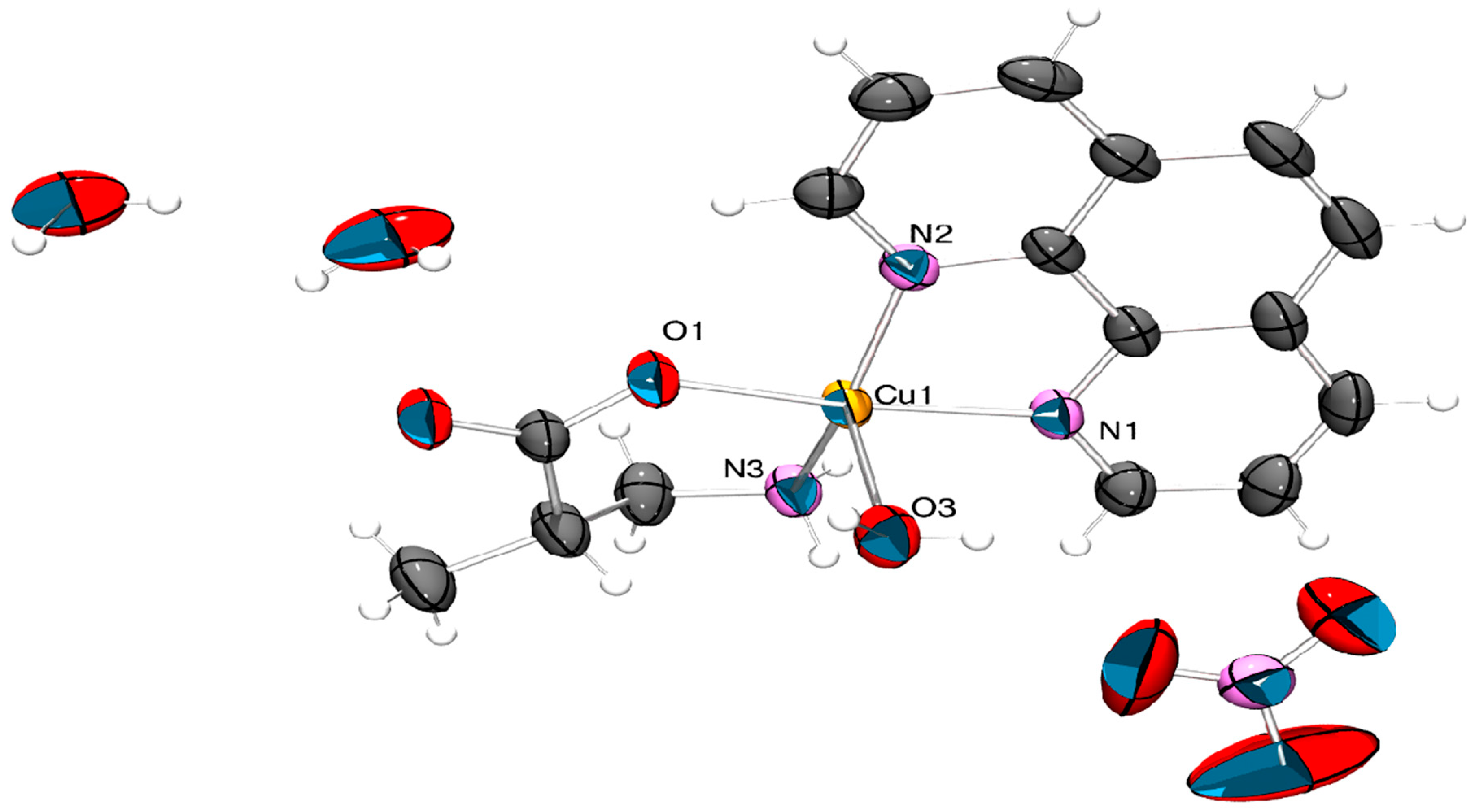
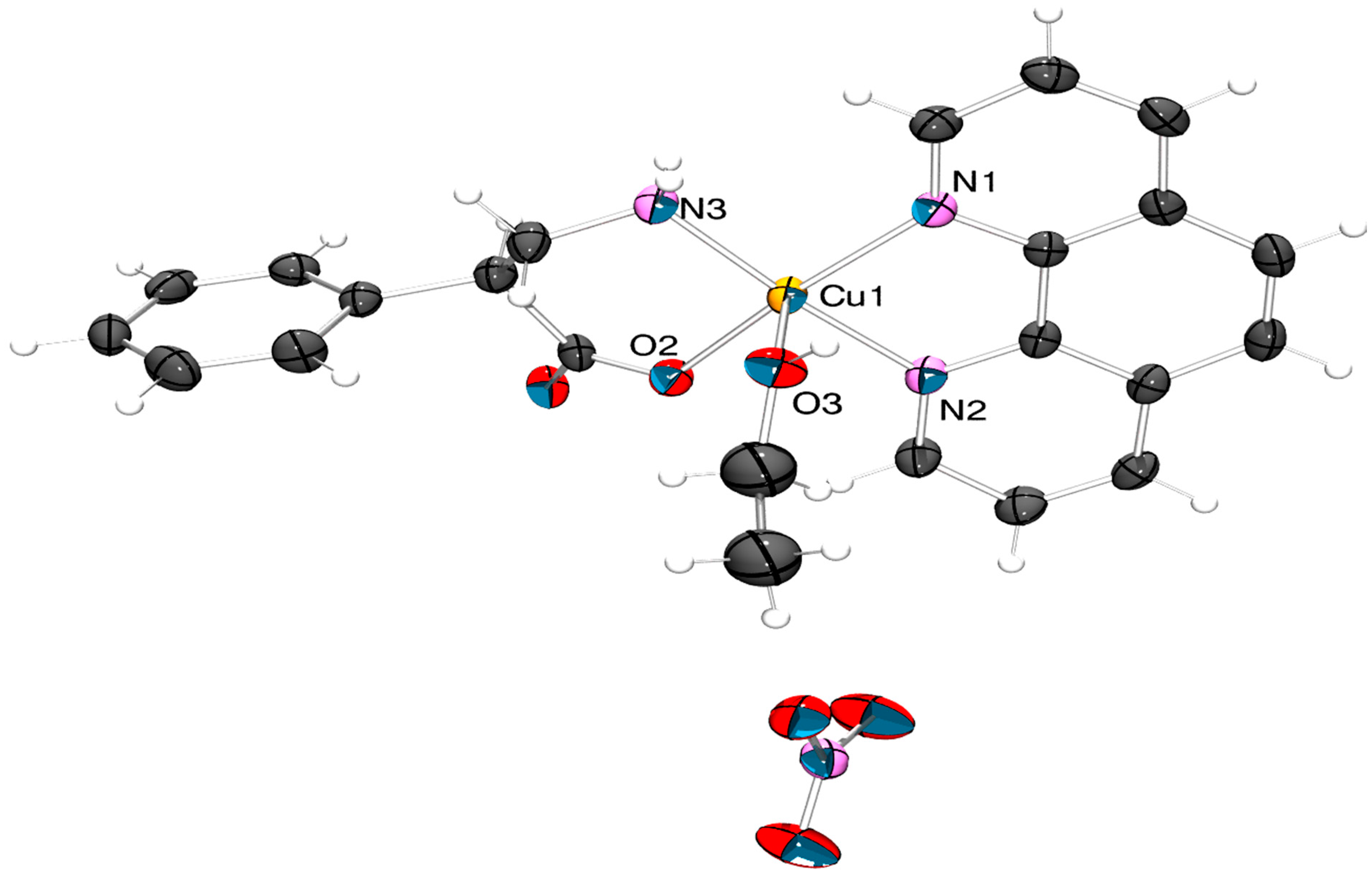
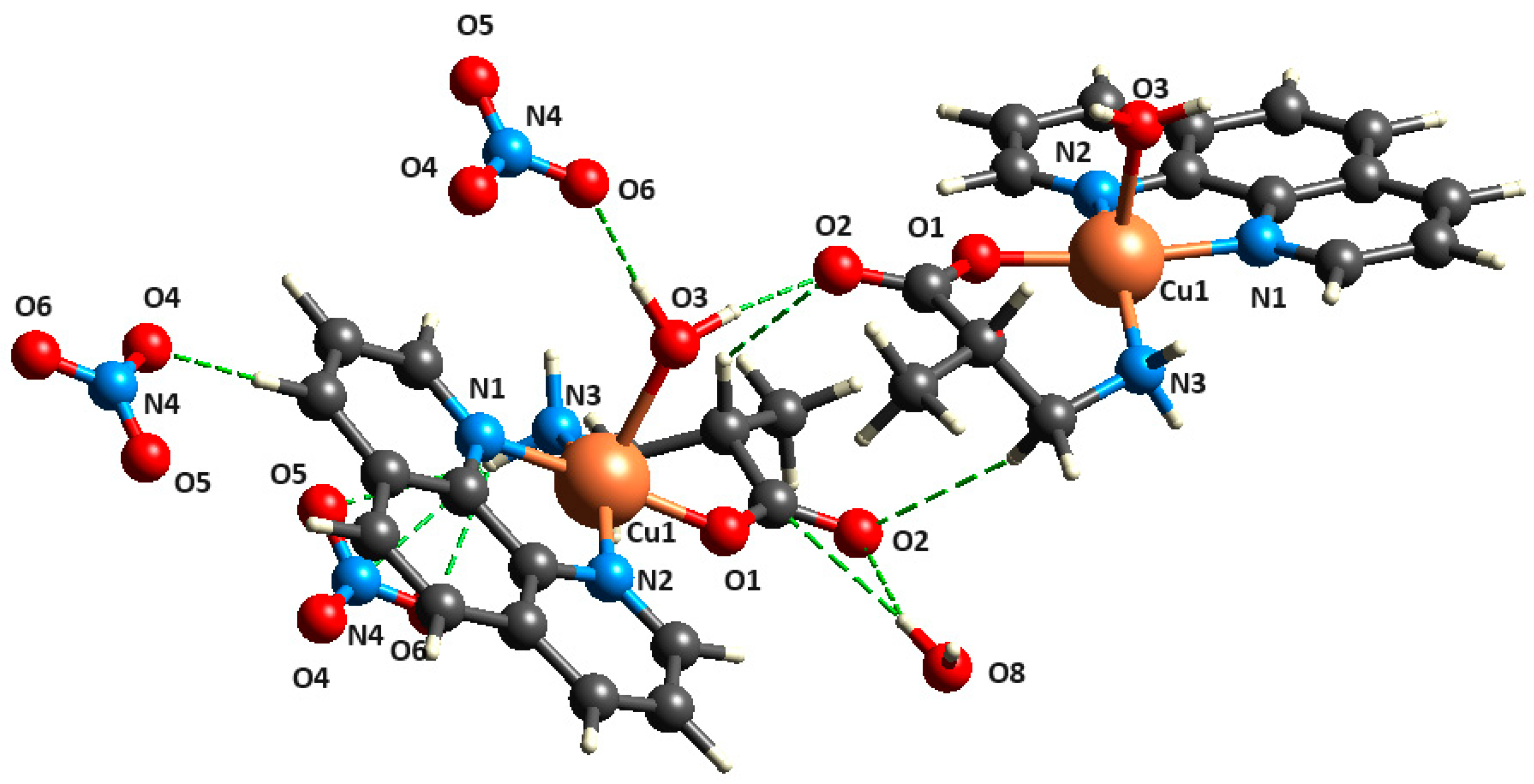

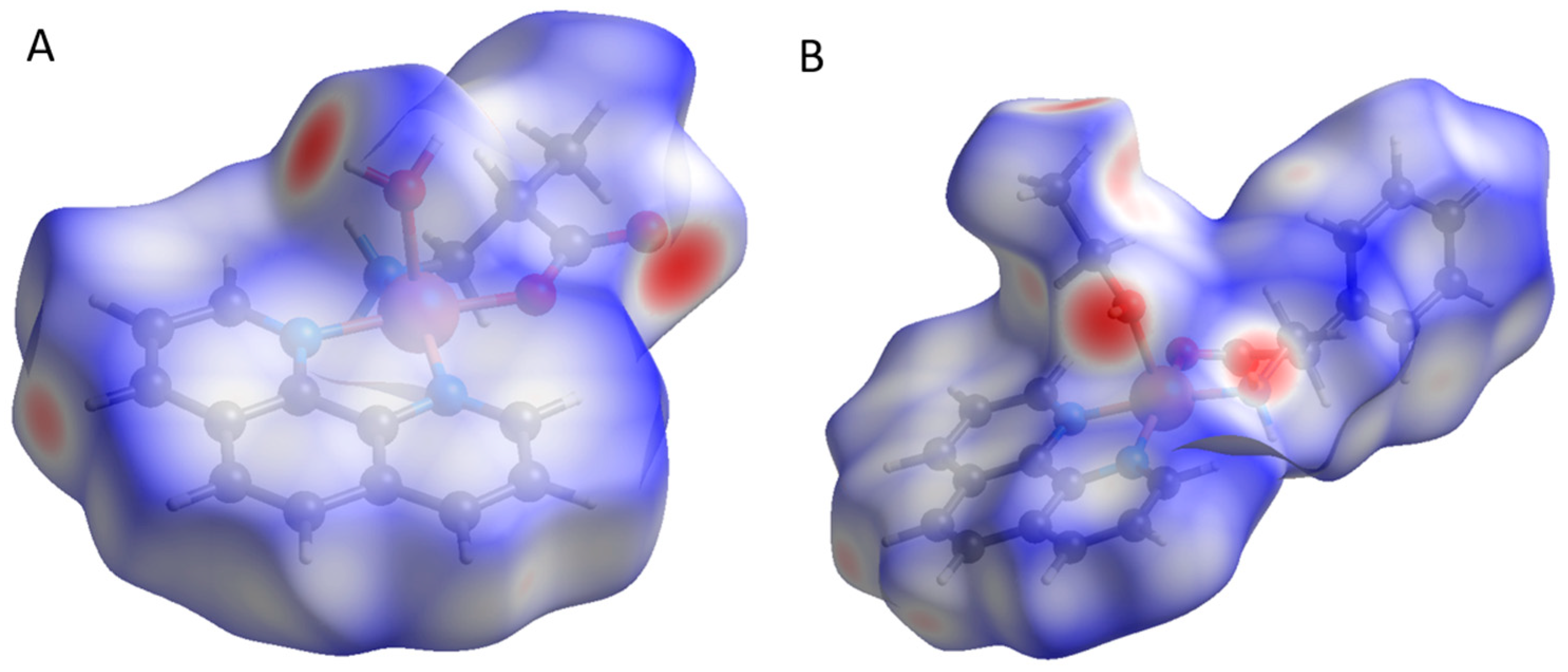
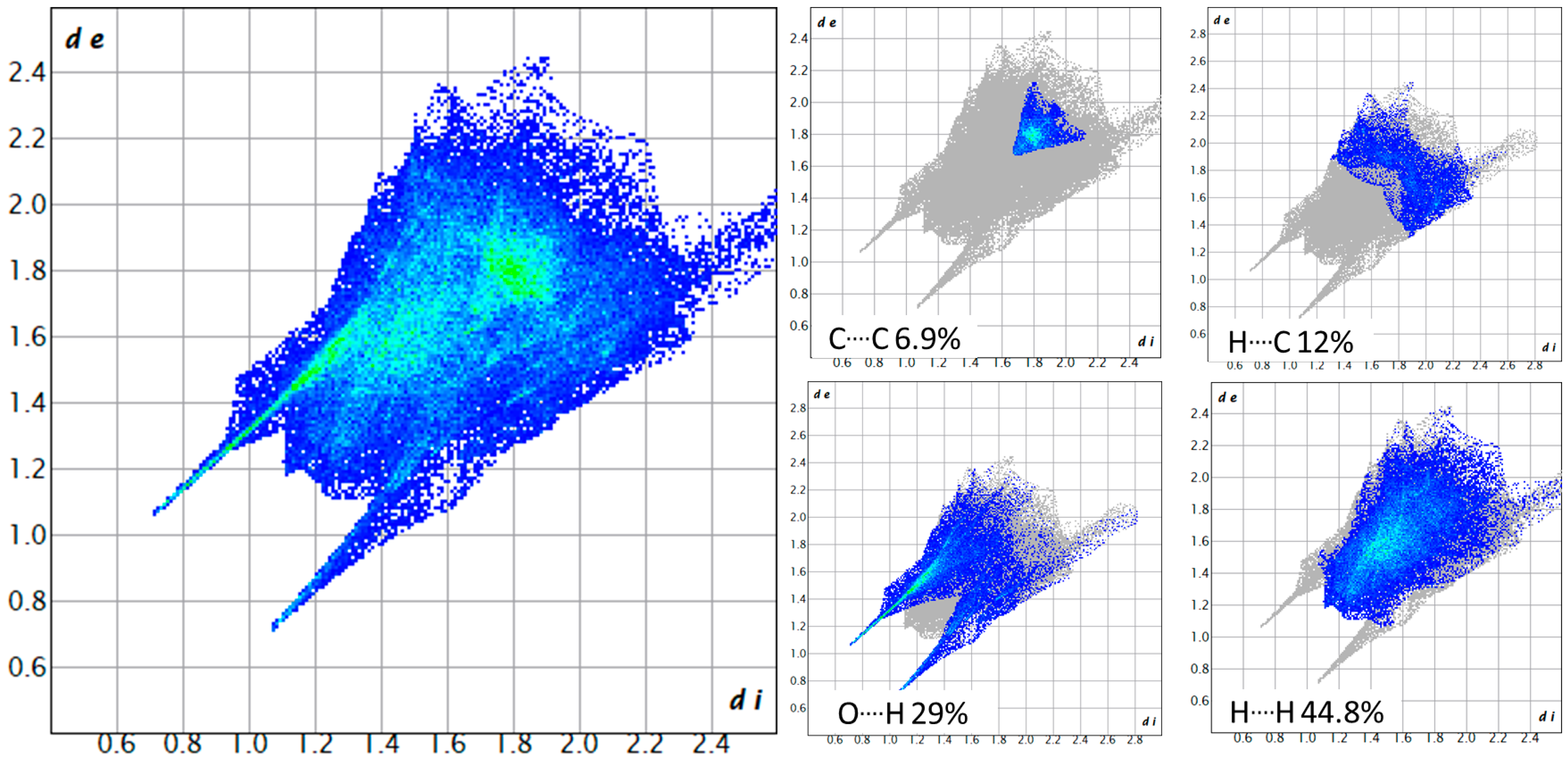
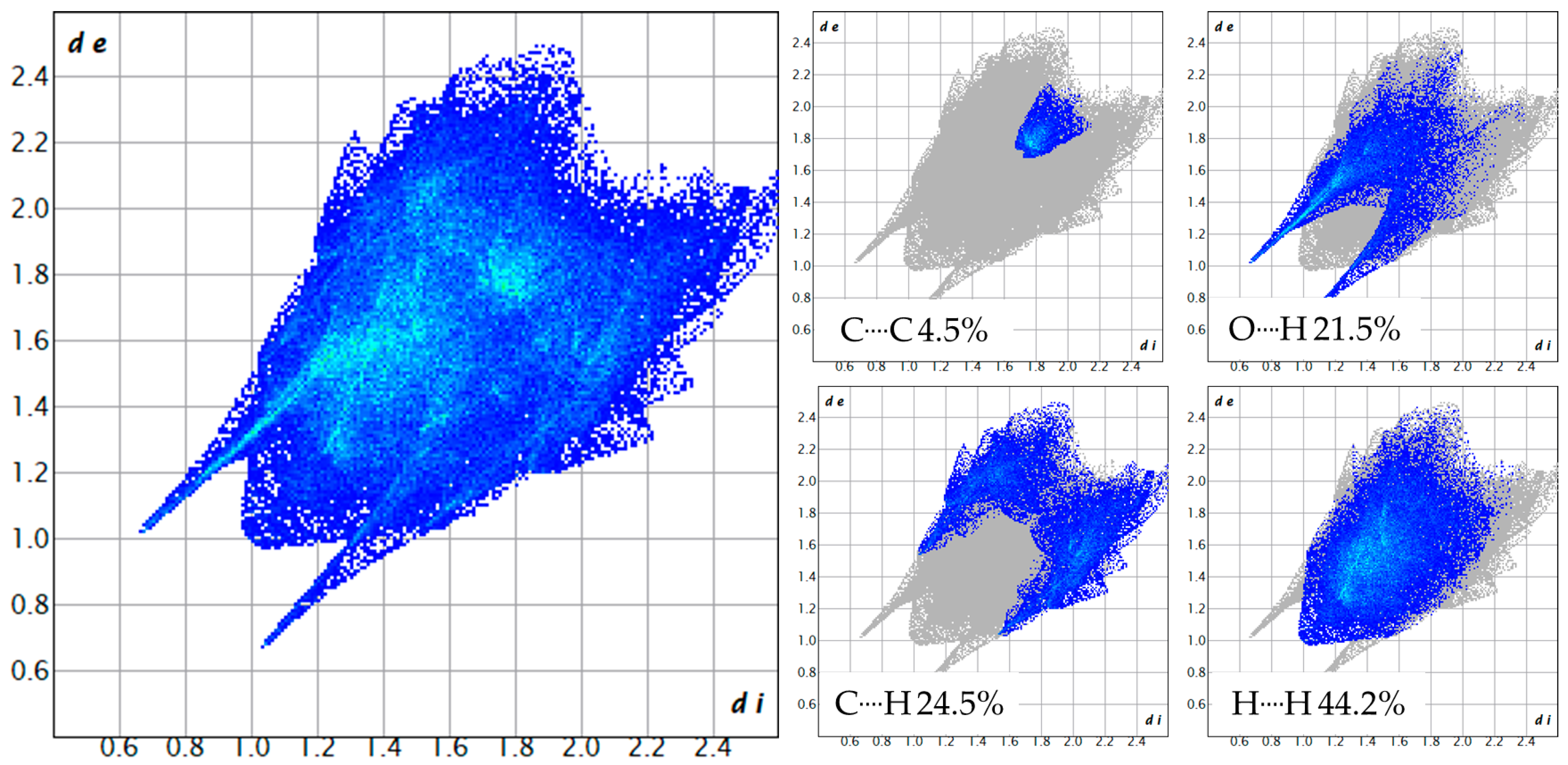
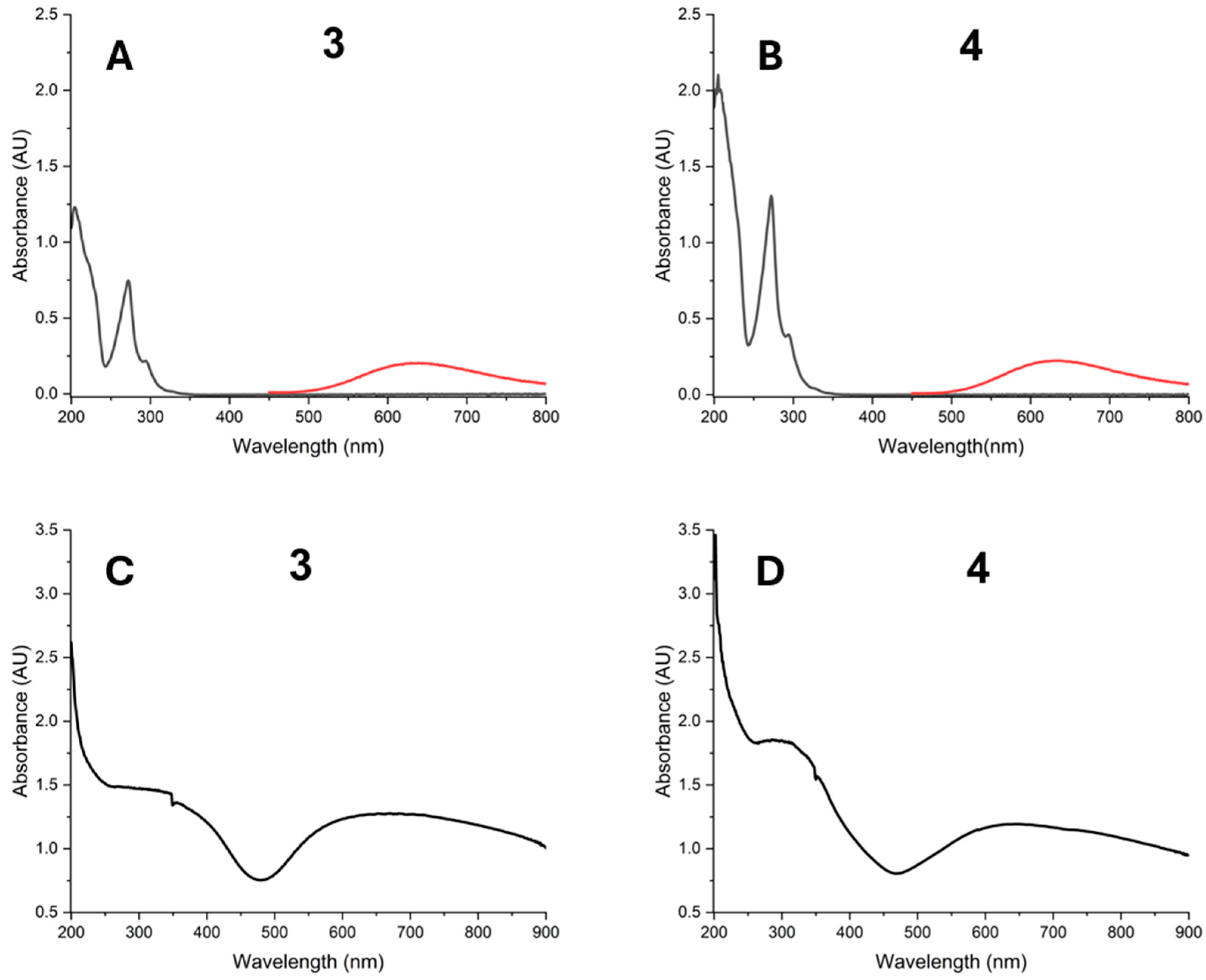
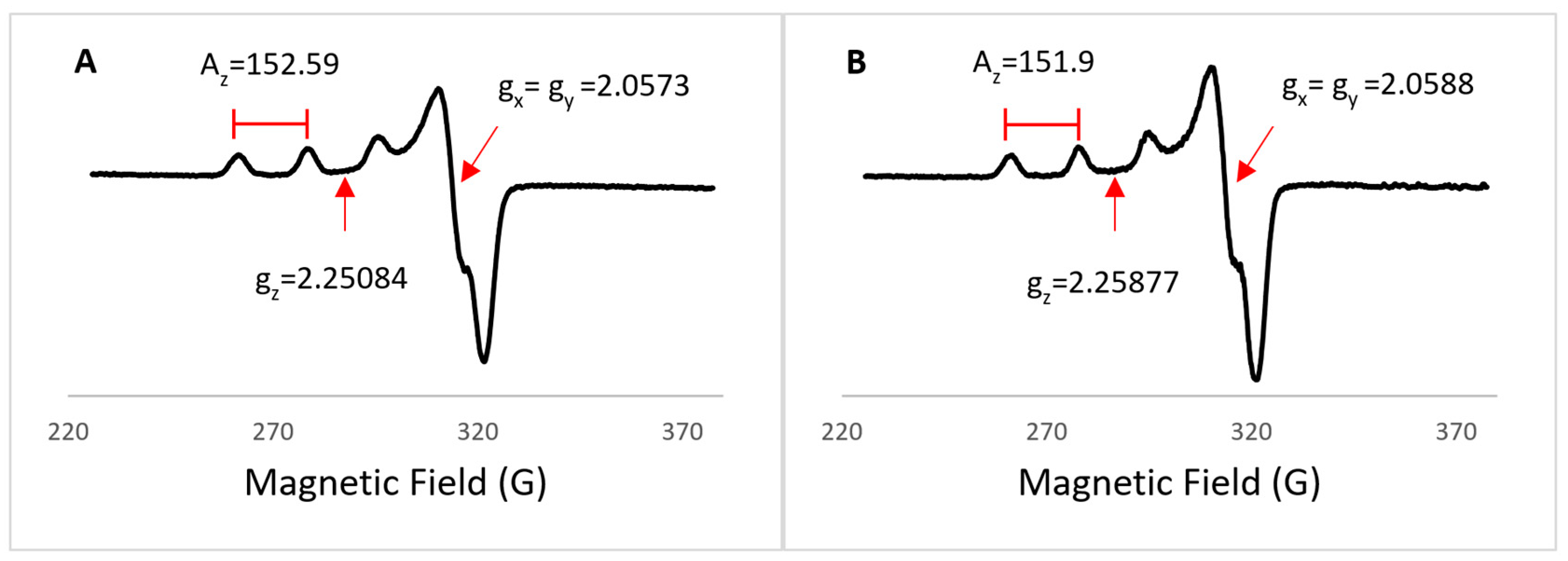

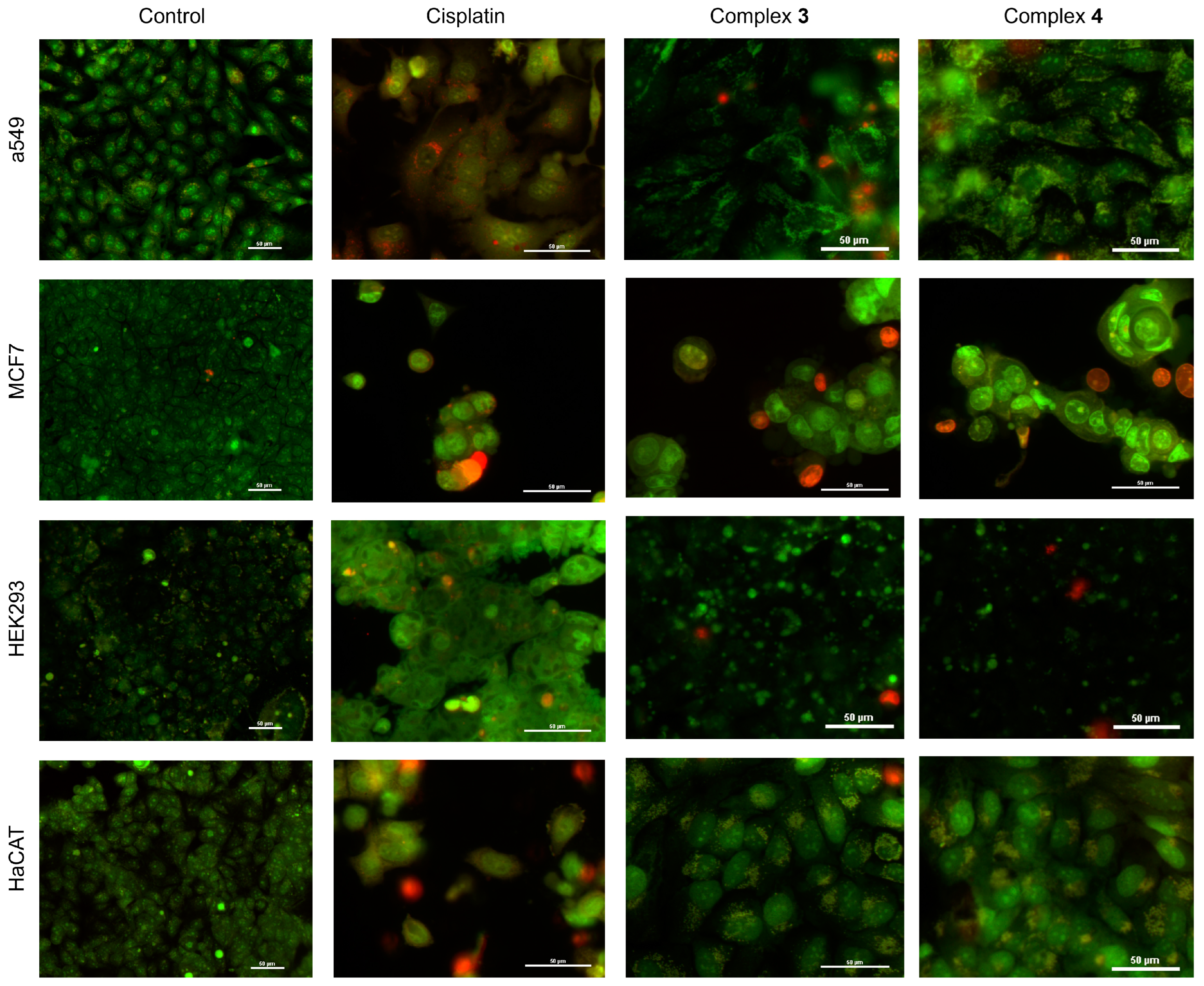
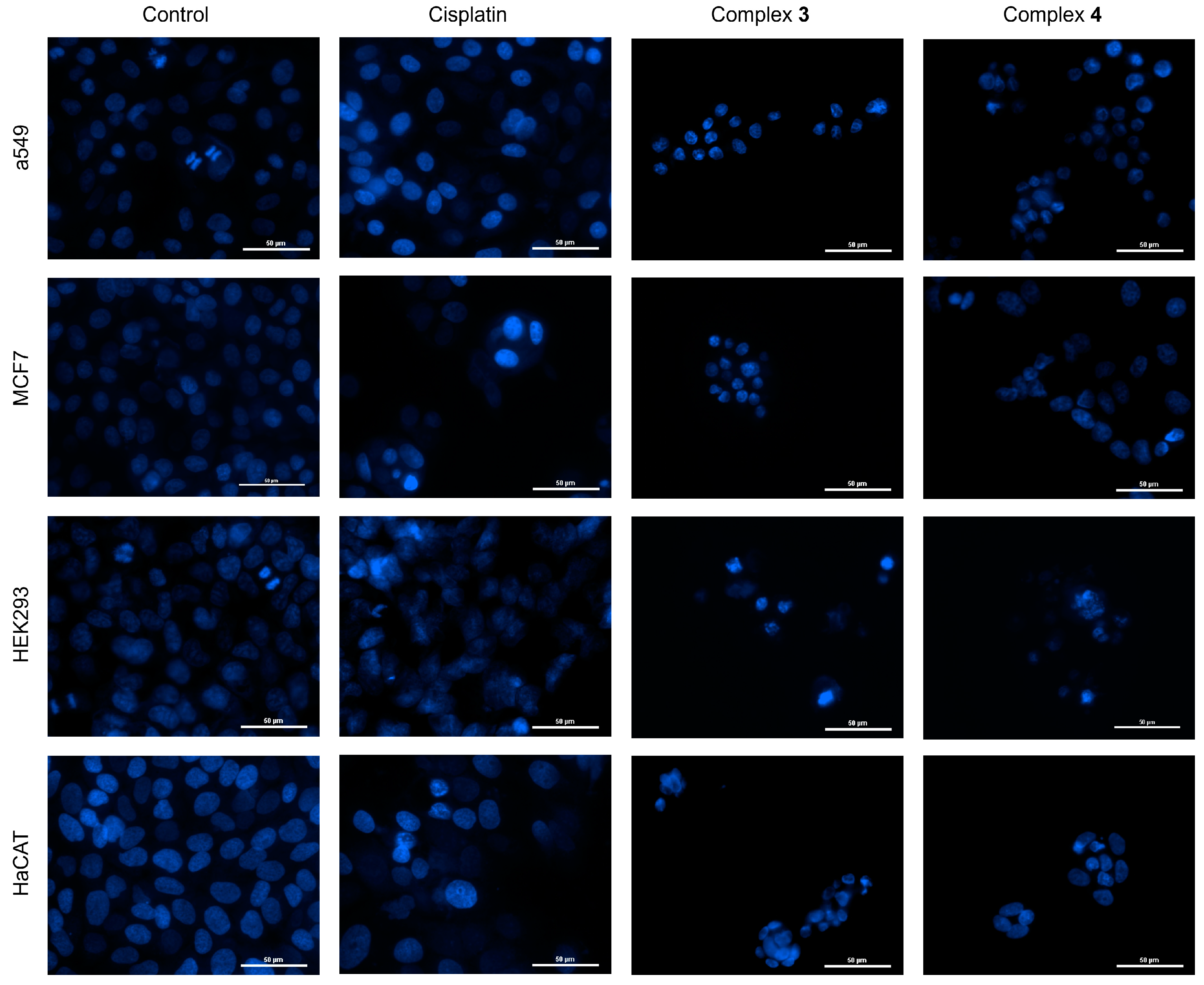



| Compound | ν(NH/OH) | ν(C=O) | ν(C–O) | ) | ν(C=N) |
|---|---|---|---|---|---|
| 3 | 3137 3227 | 1567 | 1234 | 1335 | 1511 |
| 4 | 3139 3237 | 1568 | 1224 | 1326 (broad) | 1519 |
| Compound | Atom–Atom | Length (Å) | Atom–Atom–Atom | Angle (°) | Atom–Atom–Atom | Angle (°) |
|---|---|---|---|---|---|---|
| 3 | Cu–O1 | 1.918 | O1–Cu–O3 | 92.96 | N2–Cu–O3 | 101.89 |
| Cu–O3 (H2O) | 2.295 | O1–Cu–N1 | 170.44 | N2–Cu–N1 | 81.56 | |
| Cu–N1 | 2.026 | O1–Cu–N2 | 89.45 | N3–Cu–O3 | 101.82 | |
| Cu–N2 | 2.023 | O1–Cu–N3 | 95.04 | N3–Cu–N1 | 94.5 | |
| Cu–N3 | 1.976 | N1–Cu–O3 | 85.78 | N3–Cu–N2 | 155.59 | |
| 4 | Cu–O2 | 1.955 | O2–Cu–O3 | 95.45 | N2–Cu–O3 | 92.9 |
| Cu–O3 (EtOH) | 2.223 | O2–Cu–N1 | 166.77 | N2–Cu–N1 | 81.28 | |
| Cu–N1 | 2.063 | O2–Cu–N2 | 89.61 | N3–Cu–O3 | 93.26 | |
| Cu–N2 | 2.003 | O2–Cu–N3 | 93.05 | N3–Cu–N1 | 94.97 | |
| Cu–N3 | 1.966 | N1–Cu–O3 | 94.57 | N3–Cu–N2 | 173.03 |
| Compound 3 Bond | D····H, (Å) | H····A, (Å) | D····A, (Å) | D····H, (°) | Compound 4 Bond | D····H, (Å) | H····A, (Å) | D····A, (Å) | D····H, (°) |
|---|---|---|---|---|---|---|---|---|---|
| O3–H3A····O2 | 0.79 | 1.99 | 2.773 | 171 | O3–H3····O1 | 0.98 | 1.72 | 2.691 | 172 |
| O3–H3B····O6 | 0.82 | 2.00 | 2.809 | 168 | N3 –H3A····O5 | 0.89 | 2.12 | 2.985 | 165 |
| N3–H3C····O5 | 0.86 | 2.55 | 3.361 | 159 | N3–H3B····O5 | 0.87 | 2.60 | 3.160 | 124 |
| N3–H3C····O6 | 0.86 | 2.32 | 2.999 | 136 | N3–H3B····O6 | 0.87 | 2.19 | 3.010 | 159 |
| N3–H3D····O7 | 0.84 | 2.13 | 2.958 | 175 | C5–H5····O6 | 0.95 | 2.568 | 3.491 | 164.1 |
| O7–H7····O8 | 0.77 | 2.10 | 2.831 | 160 | C9–H9····O2 | 0.95 | 2.446 | 2.954 | 113.3 |
| O8–H8A····O5 | 1.00 | 1.98 | 2.878 | 149 | C11–H11····O1 | 0.95 | 2.413 | 3.335 | 163.5 |
| O8–H8B····O2 | 1.00 | 1.84 | 2.804 | 162 | C19–H19····O1 | 0.95 | 2.562 | 3.430 | 151.9 |
| C3–H3····O4 | 0.93 | 2.36 | 3.283 | 173 | C23–H23B····O4 | 0.98 | 2.21 | 2.924 | 128.4 |
| C10–H10····O1 | 0.93 | 2.49 | 2.971 | 112 | C23–H23C····O6 | 0.98 | 1.791 | 1.791 | 174.2 |
| Compound | gz | gx = gy | giso a | Az b | Ax = Ay b | Aiso b,c | gz/Az | μeff (BM) |
|---|---|---|---|---|---|---|---|---|
| 3 | 2.25084 | 2.0573 | 2.1218 | 152.59 | 14.7 | 60.66 | 147.5 | 2.07 |
| 4 | 2.25877 | 2.0588 | 2.1254 | 151.9 | 15.1 | 60.7 | 148.7 | 1.55 |
| Compound | HEK293 | HaCaT | A549 | MCF-7 |
|---|---|---|---|---|
| 3 | 0.19 ± 0.01 | 0.21 ± 0.02 | 0.24 ± 0.02 | 0.35 ± 0.02 |
| 4 | 0.32 ± 0.02 | 0.35 ± 0.09 | 0.22 ± 0.05 | 0.40 ± 0.02 |
| Cisplatin b | 25 | 25 | 25 | 25 |
| Cu(NO3)2 | 47.63 ± 3.22 | 55.50 ± 2.03 | 47.82 ± 3.22 | 70.23 ± 2.03 |
Disclaimer/Publisher’s Note: The statements, opinions and data contained in all publications are solely those of the individual author(s) and contributor(s) and not of MDPI and/or the editor(s). MDPI and/or the editor(s) disclaim responsibility for any injury to people or property resulting from any ideas, methods, instructions or products referred to in the content. |
© 2025 by the authors. Licensee MDPI, Basel, Switzerland. This article is an open access article distributed under the terms and conditions of the Creative Commons Attribution (CC BY) license (https://creativecommons.org/licenses/by/4.0/).
Share and Cite
Chavelas-Hernández, L.; Hernández-Vázquez, L.G.; Valdez-Camacho, J.R.; Espinoza-Guillén, A.; Tavira-Montalvan, C.A.; Meneses-Acosta, A.; Juaristi, E.; Ruiz-Azuara, L.; Escalante, J. Synthesis of (1,10-Phenanthroline-κ2N,N′)(β2-Methyl- and β2-PhenylAlaninate-κ2N,O)Copper(II) Nitrate Complexes and Their Antiproliferative Activity on MCF-7 and A549 Cancer Cell Lines. Molecules 2025, 30, 634. https://doi.org/10.3390/molecules30030634
Chavelas-Hernández L, Hernández-Vázquez LG, Valdez-Camacho JR, Espinoza-Guillén A, Tavira-Montalvan CA, Meneses-Acosta A, Juaristi E, Ruiz-Azuara L, Escalante J. Synthesis of (1,10-Phenanthroline-κ2N,N′)(β2-Methyl- and β2-PhenylAlaninate-κ2N,O)Copper(II) Nitrate Complexes and Their Antiproliferative Activity on MCF-7 and A549 Cancer Cell Lines. Molecules. 2025; 30(3):634. https://doi.org/10.3390/molecules30030634
Chicago/Turabian StyleChavelas-Hernández, Leticia, Luis G. Hernández-Vázquez, Jonathan R. Valdez-Camacho, Adrián Espinoza-Guillén, Carlos A. Tavira-Montalvan, Angélica Meneses-Acosta, Eusebio Juaristi, Lena Ruiz-Azuara, and Jaime Escalante. 2025. "Synthesis of (1,10-Phenanthroline-κ2N,N′)(β2-Methyl- and β2-PhenylAlaninate-κ2N,O)Copper(II) Nitrate Complexes and Their Antiproliferative Activity on MCF-7 and A549 Cancer Cell Lines" Molecules 30, no. 3: 634. https://doi.org/10.3390/molecules30030634
APA StyleChavelas-Hernández, L., Hernández-Vázquez, L. G., Valdez-Camacho, J. R., Espinoza-Guillén, A., Tavira-Montalvan, C. A., Meneses-Acosta, A., Juaristi, E., Ruiz-Azuara, L., & Escalante, J. (2025). Synthesis of (1,10-Phenanthroline-κ2N,N′)(β2-Methyl- and β2-PhenylAlaninate-κ2N,O)Copper(II) Nitrate Complexes and Their Antiproliferative Activity on MCF-7 and A549 Cancer Cell Lines. Molecules, 30(3), 634. https://doi.org/10.3390/molecules30030634









